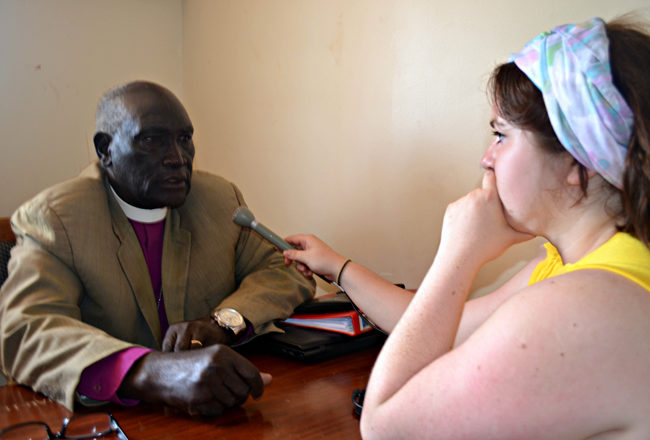Can Kickstarter and Indiegogo deliver a new way to pay for journalism?
Crowdfunding is tempting for reporters with ambitions greater than their financing, but it’s not for everyone
When CBC moved into Hamilton, Ontario, local journalist Joey Coleman couldn’t compete. He decided “I’m done. I am going to stop covering news.” That meant saying goodbye to a readership gained from work with Maclean’s, The Globe and Mail and The Hamilton Spectator. But when people offered to fund him themselves in the fall of 2012, Coleman launched a crowdfunding campaign to provide original reporting on his own site. His page on Indiegogo claimed, “This will be Hamilton journalism, accountable to Hamiltonians.” He raised more than $10,000 in just under two months.
Coleman has now completed three successful campaigns on the crowdfunding site, raising a total of $21,034. It’s impressive, but it’s not enough. “I barely make any money at it,” says Coleman. “I have enough to pay the bills and that’s about it.” Despite all its promise, crowdfunding is unlikely to be journalism’s future business model. Running a campaign is a second full-time job, one that relies on a cultivated brand name, far-reaching social networks and the ability to present a compelling project idea to a specific community. Even then, steady income isn’t guaranteed. So while journalists will be tempted by crowdfunding, they may find it more work than it’s worth.
Crowdfunding became an inescapable buzzword for many Canadians last summer when Gawker raised more than $200,000 on Kickstarter to buy a video of Toronto’s Mayor Rob Ford smoking crack. In the fall, The Tyee, a British Columbia-based online magazine, raised $100,000 to finance a national expansion. Today, the National Crowdfunding Association of Canada (NCFA) lists 83 crowdfunding sites for anything from general projects, like fundrazr.com, to community-targeted project sites such as crowdhelps.com, which focuses on campaigns for women. None of them are as well known as Kickstarter or Indiegogo, and none of them specialize in journalism. A third of the 21 campaigns currently listed on the NCFA website are run on the two American platforms. Coleman started using Indiegogo because it was one of the few places to raise money back in 2012.

Joey Coleman, seen here at work live-streaming a meeting at Hamilton City Hall, stayed in journalism thanks to the success of his crowdfunding campaigns (PHOTO CREDIT: COURTESY OF JOEY COLEMAN)
Sarah Petz also chose Indiegogo. For her final master of journalism project at Carleton University, she wanted to investigate the fallout after battles between the military and rebels pushed some Ugandans from their land. A travel grant provided close to $3,000, but producing a radio documentary would be a lot more expensive than that. She’d heard about people using crowdfunding for their own projects, and thought, “Why the hell not?”
Even though Petz made it to Uganda and collected more than 100 interviews, she insists that the entire process was a trial by fire. She raised only $1,530 of the projected $5,000, and most of it went to drivers and translators in Uganda. Petz had to use her savings to pay for her equipment and travel. (Equipment is usually the biggest expense—a camera, along with the equipment required to live-stream, can cost up to $9,500.)
Petz’s campaign ran while she was interning at the National Post, and it did raise awareness about her project. “It was a lot of work, and if I had to do it again I would be more strategic,” she says. Instead of repeatedly approaching her immediate social circles, she could have targeted those communities that would be specifically interested in a Ugandan story. “It’s hard to galvanize people to give otherwise.”

For her trip to Uganda, journalism student Sarah Petz raised some money through crowdfunding, but not all (PHOTO CREDIT: COURTESY OF SARAH PETZ)
Crowdfunded journalists soon realize the strain of playing both campaign manager and reporter; the two roles must complement each other to lead to profit. As Petz discovered, campaign or brand management is a consuming job. The list of responsibilities is long: maintain the website, research the market, film and edit a campaign video and chase donors. Once the project’s over, the work isn’t. Donations are taxable income and Cleo Hamel, a senior tax analyst with H&R Block, says the onus is on the journalist to know how to report the funds he or she raised.
Maintaining and growing a readership also involves maintaining a good reputation, because as Coleman says, “I’m not selling a concept so much as I’m selling myself.” He suggests reporters who do not have established reputations partner with journalism schools or big establishments. This can also mean sites like gojournalism.ca, owned by Algonquin College in Ottawa, which marries story pitches from journalists with interested readers in an effort to help reporters raise funding.
The advantage of crowdfunded journalism is that it’s a direct transaction in which donors pay for their news from a trusted vendor. But funding a campaign is different from other audience-paid news because donations are completely voluntary. Coleman says, “When I talk to people willing to pay for news, I often hear, ‘I hate the paywall, I’m here for the news.’”
Contributing to a campaign directly connects readers to their main interest—the reporting. Journalists can deliver exactly what their audience wants: relevant, accountable and accurate news. After he established a reputation, Coleman found that readers didn’t hesitate to support him: “If you support journalism…you’re either all in or you’re not.”
A previous version of this piece stated that CBC decided to make no local hires when it moved into Hamilton, Ontario. There was no such policy in place. The Review regrets this error.
Related Posts
 Mental health: why journalists don’t get help in the workplace
Mental health: why journalists don’t get help in the workplace How BlackBerry execs bullied journalists and why nobody fought back
How BlackBerry execs bullied journalists and why nobody fought back Lone Rangers
Lone Rangers Why aren’t political reporters asking the right questions about polls?
Why aren’t political reporters asking the right questions about polls? Can crowdfunded Ricochet survive to create a journalistic utopia?
Can crowdfunded Ricochet survive to create a journalistic utopia? The dangerous pride of the innumerate journalist
The dangerous pride of the innumerate journalist
Vibz Gairola was the Production Editor for the Spring 2014 issue of Ryerson Review of Journalism.






































